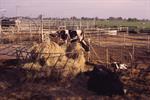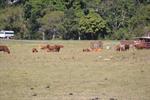 Study for a Career in Agricultural Management or Technology
Study for a Career in Agricultural Management or Technology
- Agriculture today is more than just being a farmer
- Farming is supported by factories that produce agricultural equipment and materials; research and education dealing with agricultural information, management and financial services; and much more.
- This course prepares you to work in any or all of these areas.
Modules
There are six compulsory modules; designed to develop a foundation for working in Agriculture, followed by nine (9) elective modules. With such a high proportion of electives; and a very diverse range of possibilities to choose from; every student has a unique opportunity to develop a skill set that differentiates them from their competitors in business or employment.
This course is unique, and graduates are equally unique.
Modules
Note that each module in the Qualification - Associate Diploma in Agriculture is a short course in its own right, and may be studied separately.

Whether you produce animals or harvest plants, the basis of any farm is still its plants.
For a farm to remain sustainable, certain minimum productivity levels must be maintained, using preferred plant species on an ongoing basis.
These plants may be pasture species, fodder crops, grain, vegetables, fruit or other harvested plants
Broad Acre Cropping
Monoculture is the most prevalent form of production in Western Agriculture today. It refers to a system in which almost no diversity is present at all. Crops grown in this way are often especially open to attack from weed and pest species. Many predators return annually to these farms, assured of a continual food source. Stripping crop targeted nutrients from the soil is also a major problem in a monoculture. To combat these effects farmers are required to use greater quantities of chemicals in the form of weedicides, pesticides and fertilisers.
Classic examples of monoculture can be witnessed throughout continents such as Australia and North America where vast tracts, millions upon millions of hectares of land are used for wheat and other grain crops. The species being produced are generally fast growing, high yielding, hybrid varieties requiring considerable chemical inputs. They are often sterile varieties and seed must be purchased for each planting. The seed suppliers are often the same or sister operations to those that provide the required chemicals needed to protect the crops from insects and disease.
Aside from the problems of poor land management and heavy use of chemicals that the monoculture farm can create, the primary producer must remain viable . Quantity of production and most productive use of land can be heavily influenced by perceptions of economic viability.
There are examples of systems that are predominantly monoculture that are relatively successful in terms of sustainability. The reason for this is because the people who use these systems are aware of the dangers of monoculture, especially in terms of chemical use, and have therefore developed sustainable natural defensive measures.
One method that is employed is to plant species rich islands that are located centrally at intervals throughout the crop. These resource islands, which can be made up of literally hundreds of different indigenous plant species, seem to work quite effectively at controlling pest and disease populations as well as increasing soil fertility.
Research is still being conducted to assess to what degree these islands are successful but it would appear that the concept works. Further work on which alternative species are the most beneficial will help to ensure the resource islands are most effective. This concept is very similar to the permaculture ethic of companion planting although it exists on a far grander and perhaps greater diversity scale.
Many of the problems associated with monocultures can be minimised by simply rotating crops. As a general rule, in situations where there are more problems, leave greater time periods between plantings of the same crop. Sustainability may be improved by the following:
- Grow a crop or crops for half of the year, and graze the same area the other half.
- Grow several different crops on the farm, and rotate them so the same crop is not grown in the same paddock more than once every 2 to 3 years (or preferably longer).
- Fallow areas between crops (ie. do not graze or grow a crop).
- Grow cover crops for green manure at least annually to revitalise the soil.
- Ley Farming Systems -This involves alternating cereal grain production with pasture. Annual medics or sub clover are useful in these systems, mixed with grasses, to produce high quality forage.
Livestock Farming
To farm livestock, the following must be done:
- Select breeds of livestock appropriate to the site
- Control overstocking
- Use an appropriate production system
- Apply appropriate landcare practices to sustain the condition of the land (eg. subdivion fencing according to soil types and land use).
Before selecting a breed, determine the type & quantity of feed (and water) available. Discuss any proposed selection with people who know the local area. Consider the way in which the livestock might need to be managed (eg. fencing requirements, frequency of moving animals, etc). You need to have the manpower, equipment and financial resources needed to manage the chosen breed in a sustainable way. If you don't have adequate resources, you might be better to choose a different type of animal (eg. Goats are good in a paddock for a while to eradicate weeds; but at a certain stage, they can start to cause degradation of land).
Optimum stocking rate of a property may vary from month to month, and year to year; according to seasonal changes, and unproductive periods such as drought.
Supplementary feeding and watering may allow stocking rates to be increased on a property; or at least maintained during periods of poor pasture growth. Animals may also be put elsewhere under agistment at times, to relieve their influence on the property.
If animals are allowed total freedom on a property, problems may develop (eg. They may congregate in one particular area, causing erosion; or they may eat one particular pasture species, causing a change in the pasture composition. Generally animals are restricted to different areas at different times.
